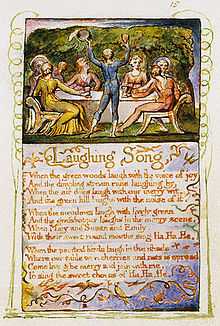Laughing Song
"Laughing Song" is a poem by the English poet William Blake. This poem is one out of nineteen in Blake's collection Songs of Innocence.
History of the Author
William Blake was born one of seven children on November 28, 1747. He was born and raised in London during a time of social and political change, which made him want to bring out a change in both through his writing. Some of Blake's most famous poems were "The Tyger", "The Poison Tree" and "The Lamb" which are all a part of his collection Songs of Innocence and of Experience. Songs of Innocence also displayed not just him as a poet, but also displayed the great painter that he was; illustrating all of the poems that are in the collection.
Analysis of the Poem

“Laughing Song” is a three-stanza lyric poem. Its rhyme scheme consists of abcc/aabb/abcc. The title of this poem and its rhyme scheme is very appropriate for the message that Blake is trying to convey. The title in itself states that this is a song about laughter, and the three stanzas give this impression, especially in these lines:
With their sweet round mouths sing "Ha, ha he!"
Then again in the third stanza,
To sing the sweet chorus of "Ha, ha, he!"
Using words like “sing” and “chorus” to emphasize it as well. Blake’s main goal is to lure readers to the happiness of the prelapsarian times, when things were unspoiled and innocent. Blake is inviting the readers to take part in the celebration after all nature and all the people have began to laugh and be merry, he wants all to come join in the song. In the idea of prelapsarian/postlapsarian times, he knows that this great joy won't last forever. This is why we starts the poem with the laughter and happiness of nature in the first stanza, personifying the wood, hills, and air. In the second stanza, Blake gradually goes on to the “grasshopper” and “Mary and Susan and Emily” the children who will also joins in the singing of the “Ha, ha, he!” The children and grasshopper also reiterates the idea of innocence and joy. Using repetition of the words "merry" and "laughs/laughing" also emphasises the overall tone of the poem.
Illustration
The illustration (on the right) will also gives a great visual of what Blake was trying to express. In the picture you can tell there was a gathering or celebartion of some sort. This celebration is outdoor, so all are on with nature and laugh with the trees as expressed in the poem. The colour in the image are vibrant and the border of birds adds a joyous touch.
References
- Blake, William. "Songs of Innocence and of Experience, Copy B, 1789, 1794 (British Museum): Electronic Edition." Songs of Innocence and of Experience, Copy B, 1789, 1794 (British Museum): Electronic Edition. Morris Eaves, Robert N. Essick, and Joseph Viscomi, n.d. Web. 05 Dec. 2013.
- "William Blake." : The Poetry Foundation. N.p., n.d. Web. 04 Dec. 2013.
- "Summary and Analysis of Laughing Song by William Blake." Beaming Notes. N.p., n.d. Web. 05 Dec. 2013.